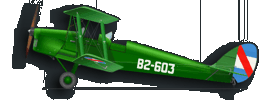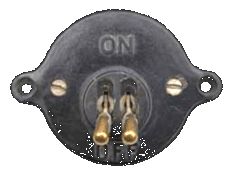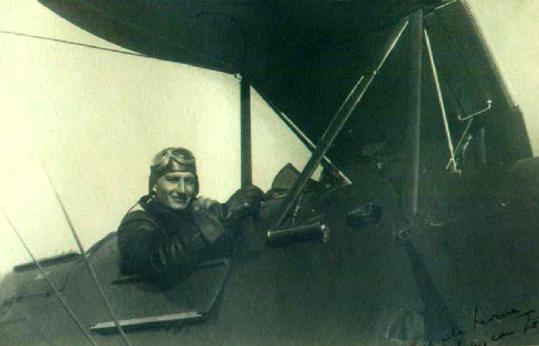|
 Service
history Service
history
1946
|
As already mentioned, at the beginning of 1946, six machines of the
EMAer were off line for a programme of maintenance work. No 601,
which had been in the workshops since the beginning of October, was
eventually flown to Boiso Lanza where it was to remain under a
continuing very slow maintenance schedule until May 1948!
These low priorities would get worse as far as the other DH82As were
concerned in the course of the current year and the next.
The reasons for this situation are clear and logical: Military
Aeronautics had continued to invest in new aircraft. In the last two
years, four Piper AE-1, half a dozen AT-6 and fifty Fairchild PT-26
primary trainers of Canadian origin were ordered of which thirty-six
were already in service. This whole new intake completely absorbed
the time and effort of the workshop personnel in maintaining these
more modern machines.
Also, in the United Kingdom the production of the Tiger Moth had
ended and the procurement of certain spare parts was becoming
difficult and un-economic. Nonetheless, and in accordance with the
schedule, by March, the EMAer had three of its Tiger Moths ready on
the line to be flown by seven Junior Lieutenants and two First
Lieutenants as part of their respective Applied Courses and
promotion.
On 7 April 1st Sergeant Hilario Almandós completed a series of five
flights towing gliders from fields in the district of San Jose. This
mission, which operated from the glider base at Melilla, was carried
out in 607 and was one of the last exercises to be completed by this
machine.
Two days later 603 reappeared at the School, after an 11 month
overhaul at the DGTAG&S.
At this stage it became evident that the Armed Forces' budget could
not provide the time and resources necessary to maintain the
remaining twelve DH82A Tiger Moths in service.
After a careful evaluation, with technical assistance and logistics
from the firm of Regusci & Voulminot and in consultation with the
manufacturer, the decision was taken to reduce the fleet, grounding
two aeroplanes which would be used as a source of spare parts.
Towards the end of April the Ministry of Defence and the DGAM
published Order No 7592 which took Tiger Moths E-607 and B1-609 out
of action. They had accomplished 1,845 and 1,728 flying hours
respectively.
|
|
The
Tiger Moth ignition switch

The
Tiger Moth was at Aerial Base No 1, which was sited at Capt.
Boiso Lanza Aerodrome before moving to Carrasco.
This
aeroplane, which was for two people in tandem, had the
engine ignition controls situated outside the cockpits on
the left side decking. There were switches for the front
seat and rear seat but if the switches of the rear cockpit
were on, the one for the front cockpit would not turn off
the engine.
Instructor Alvarado (a Sub Officer) was sitting patiently in
the front cockpit with the engine running and with the
aeroplane facing a group of officers who were waiting their
turn to fly standing at a distance of about 12 metres.
As
nobody came to his aircraft to take over, he decided to turn
off the engine. It was customary to push the throttle
forward as the ignition was switched off but when Alvarado
turned off the front switches and advanced the throttle
lever he realised the switches for the rear cockpit were on
and the engine had not stopped.
The
Tiger Moth had no brakes and was not chocked. The aeroplane
gathered speed in the direction of the bench where the
officers were sitting. There was much running, falling on
the ground and leaping out of the way of the aeroplane which
was approaching with sinister intentions, to the desperation
of Alvarado. Two of the waiting Officers, however, had the
wits to get hold of the wing tips and stop it.
Alvarado almost got a beating as they thought it had been a
bad joke until it was proved that the rear switches were on.
(ffrom
the “Collection of Anecdotes from Our Air Force”
by
Jaime Meregalli.
Mimeographed edition, Aeronautical Museum)
|
|

Juan Arides
Borba, the first of three generations of military pilots – photo via
Immer Borba
In May, the
“air sailing” activity was repeated.
On 11th and
12th First Lieutenant Almandós flew various glider towing sorties
with 603 near the city of Minas in the district of Lavalleja.
According to
notes in the official archives, this was the last glider towing
mission to be carried out by the DH82As.
Between June
and September, the EMAer would keep an average of three Tiger Moths
in flying order. They were used for about 50 hours mainly associated
with the training of Junior Lieutenants on their Application Course,
which included several camera-gun practices in 603.
Once this
phase was over, the activity of the EMAer Tiger Moths was finished
for the year. The four aircraft on strength were flown to the
DGTAG&S for maintenance work where 601 had already been for
certificate of airworthiness renewal which had lasted for over a
year and 607 had been put out of action.
Now let us see
how the six machines assigned to the Bases were behaving.
The A.B. No 1,
as already mentioned, lost 609 in April when it was put out of
action and 605 was withdrawn from flying for the rest of the year
when she was sent to the DGTAG&S for overhaul.
In
compensation, 613 flew continuously for the next twelve months,
achieving a total of 123 hours.
At A.B. No 2,
602 had a minor accident on July 19 about 30 km east of Durazno. The
aeroplane turned over upon making a forced landing because of engine
failure and would not be airworthy again until 1948. Its crew,
Privates Lino Marquizo and Elso Acerenza were unharmed.
Aircraft 600,
also on account of engine problems, made an emergency landing on
September 30 and was out of action until March the following year.
Lastly, 611
was the machine of the year, flying 188 hours with no incidents.
|
At the
end of 1946 the Tiger Moth fleet's airborne time totalled
723 hours use; 130 less than the previous year. Of the 10
remaining aircraft, only 611 and 613 were airworthy, one at
each Base, whilst the eight others were out of service for
repairs, inspection or overhaul.
|
| B.A.Nº1 |
B.A.Nº2 |
E.M.Aer. |
|
No |
hours |
No |
hours |
No |
hours |
| 605 |
77 |
600 |
75 |
601 |
-- |
| 609 |
39 |
602 |
88 |
603 |
50 |
| 613 |
123 |
611 |
188 |
604 |
9 |
| |
|
|
|
606 |
26 |
| |
|
|
|
607 |
16 |
| |
|
|
|
608 |
32 |
| Total |
239 |
Total |
351 |
Total |
133 |
|
Avg. |
80 |
Avg. |
117 |
Avg. |
22 |
|
|
|